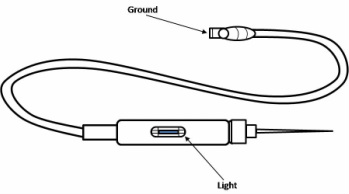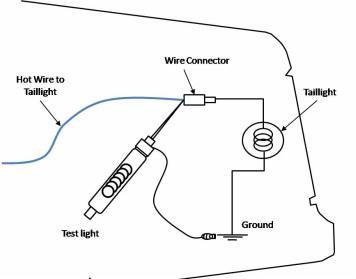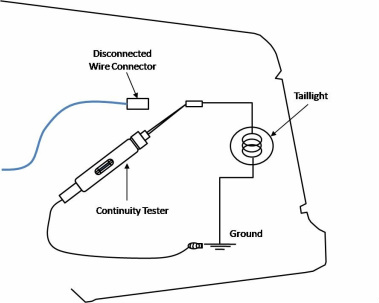
Title: Troubleshooting Simple Circuits
Description: Troubleshooting an electrical circuit can be easy if the correct procedures and tools are used. One of the easiest ways is with a testlight. A testlight is a simple testing instrument used to see if there is electricity at a certain point in an electrical circuit. See the illustration on the left. Typically, one end of the testlight is grounded. The other end of the testlight has a pointed terminal. This pointed terminal is very sharp and can be inserted through a wire insulation to touch the electrical wire inside. The testlight will light up if there is voltage available where the pointed terminal is touching the inside wire. Basically the testlight is giving the current a direct link to ground. If the testlight lights up, it means that voltage is present at that point in the circuit.
A second test instrument that is often used for troubleshooting electrical circuits is the continuity tester. This tester is used to test for open circuits when there is no electricity flowing in the circuit. It looks similar to the testlight above, but has a battery inside to provide the electricity. The battery is used to check for continuity (or a completed circuit). When the probe is touched to an electrical circuit, the light will light up if the circuit is completed or has continuity to ground.
Description: Troubleshooting an electrical circuit can be easy if the correct procedures and tools are used. One of the easiest ways is with a testlight. A testlight is a simple testing instrument used to see if there is electricity at a certain point in an electrical circuit. See the illustration on the left. Typically, one end of the testlight is grounded. The other end of the testlight has a pointed terminal. This pointed terminal is very sharp and can be inserted through a wire insulation to touch the electrical wire inside. The testlight will light up if there is voltage available where the pointed terminal is touching the inside wire. Basically the testlight is giving the current a direct link to ground. If the testlight lights up, it means that voltage is present at that point in the circuit.
A second test instrument that is often used for troubleshooting electrical circuits is the continuity tester. This tester is used to test for open circuits when there is no electricity flowing in the circuit. It looks similar to the testlight above, but has a battery inside to provide the electricity. The battery is used to check for continuity (or a completed circuit). When the probe is touched to an electrical circuit, the light will light up if the circuit is completed or has continuity to ground.

Relationship to Street Rods: A good example of how the testlight works is shown in the illustration to the left of a street rod tail light not working. First turn on the tail lights, Then place the testlight just before the wire connector with the other end to ground. If the testlight lights up, this means that there is voltage up to the wire connector. If it doesn’t light up, it means that the problem is somewhere before the wire connector. Let’s say the tester lights up. So in this case, the electrical circuitry up to the wire connector is considered to be ok. If the testlight were to be placed to the right of the wire connector, again the testlight should light up. If it does not light up, it means the wire connector is defective and is creating an open circuit. This means that the voltage has been lost across the wire connector. So most likely the problem is a defective (broken or corroded)wire connector.

The continuity tester can help troubleshoot the same electrical circuit. Referring to the illustration to the left, first the wire must be disconnected at the wire connector. This is done to remove the electricity from the vehicle battery. Then place the continuity tester from the disconnected point to ground, (across the tail light). If this circuit is completed with no breaks, the continuity tester light will light up. If the bulb or other connection points has an open, the continuity tester will not light up. If this is the case, it means that an electrical open has occurred at the light bulb (bad light bulb) or at the ground connection.
Back to Electrical Principles
Back to Electrical Principles